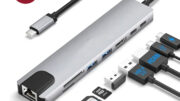If you’re like me, there hasn’t been a day in the last decade you haven’t picked up your cell phone. I’ve said it before, it’s really your most valued possession. It’s the one thing you just don’t want to leave the house without. And, cell service is certainly better than it was six or seven years ago for many people. It’s pretty rare to see people wandering around, phone in the air, trying to get a good signal. Dropped calls are a lot less common. If you’re on a call, you’re less likely to worry about sounding garbled.
Except, you know, when things don’t work out that way.
It’s true that a lot of areas that had bad cell service 10 years ago now have nice, crystal clear service. But certainly not everywhere. There are a lot of pockets of this country where you won’t even get three bars when you’re outside (or three dots, as they now seem to look on many phones.) These are areas where cell towers are still spread out too far, either because of low population or because of local city councils who are simply against large cell towers.
See, not everyone thinks a gigantic radio broadcast tower is pretty, even if you disguise it as a palm tree or hide it on the side of a water tower. There are plenty of areas that are underserved by cell service because the people there don’t want to stare at a cell tower. Maybe you live in a city or town like this.
You could lobby your local zoning board, you could bother the cell carriers, but there’s a more simple solution. Just get a cellular booster!
Cell boosters are the solution
A cellular signal booster takes a weak signal from outside — as weak as one bar — and amplifies it for use indoors. It makes it possible to get five bars inside, even if there’s only one bar outside. Let me say that again… with a cell booster you can get better reception indoors than outdoors. The secret is a much larger antenna that either attaches outdoors or sits in your window.
Everyone wants these nice small phones but that means the antennas in them are often tiny. Tiny antennas only pick up a little bit of signal, while bigger antennas pick up a much more powerful one. That powerful signal goes to an amplification system that’s so complex it can amplify your phone’s signals as well as those coming from the towers, giving you better calls in both directions and all of this happens so fast that there’s no lag.
A cell booster also constantly monitors what’s going on around it to make sure that it’s not overamplifying the signal from your phone or from the cell towers. An overamplified signal could cause problems for everyone and send screeching feedback throughout the entire area served by the cell tower. That’s why FCC rules make cell boosters automatically reduce their power levels before that can happen. It’s a pretty fancy dance, as the cell booster is constantly monitoring things to make sure that there aren’t any problems. Sure, it makes a cell booster cost more but without that monitoring they would probably be illegal… so there’s that.
Ready to make a change?
I personally believe that every home and office should have a cellular booster. It’s one of those investments you’ll wonder why you didn’t make. Think of all the times you grab your phone and think about the times when your internet was slow, or calls kept bouncing back and forth from wi-fi to cellular (with a drop in the sound every time)… your phone is THE way you communicate with the world. Why wouldn’t you invest in something to make it work better?
When you’re ready to improve the quality of your life and your cell service, shop the great selection of cell phone signal boosters at SolidSignal.com. Looking for more advice? Call us at 888-233-5834 during East Coast business hours and you’ll get a real technician who can help you make the right choice.





